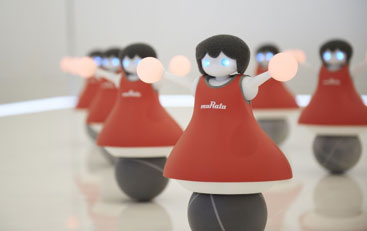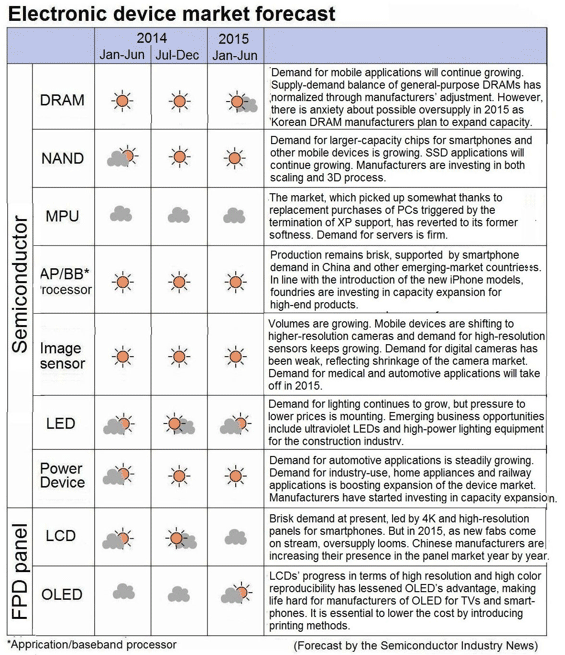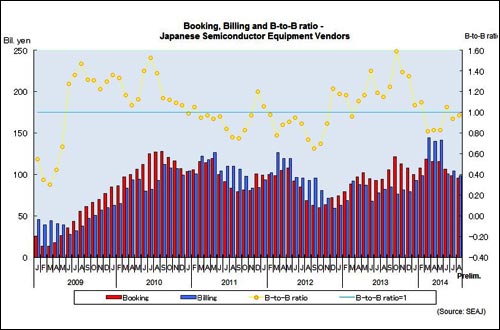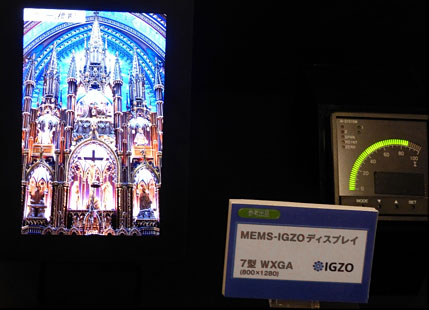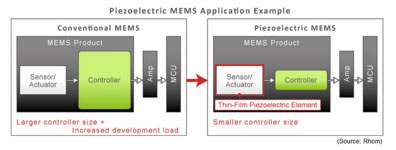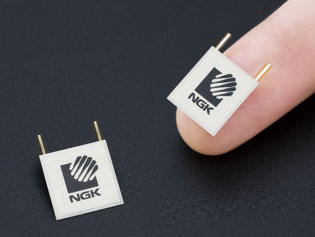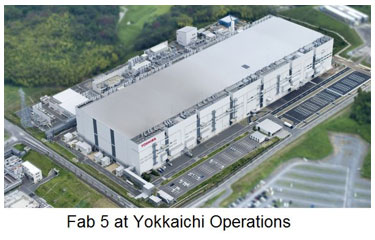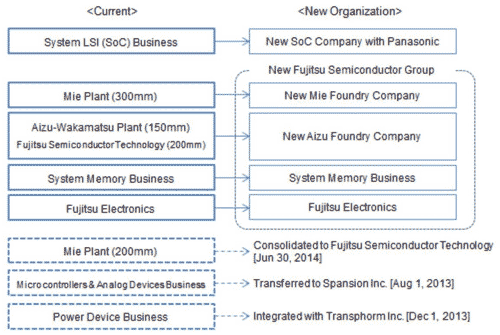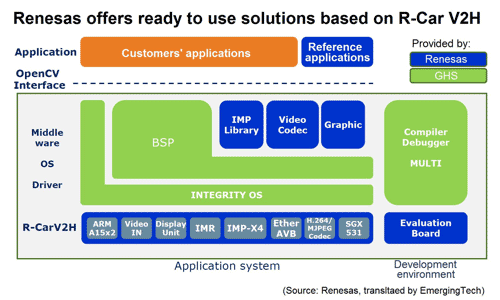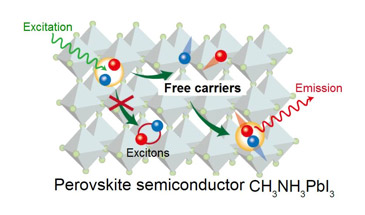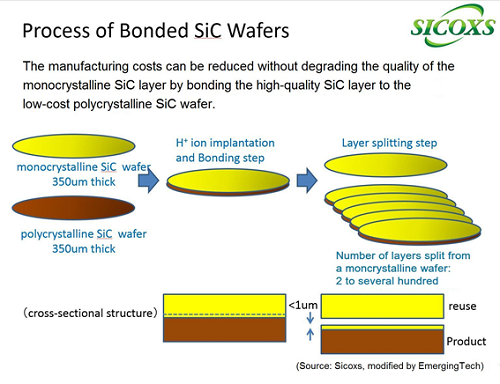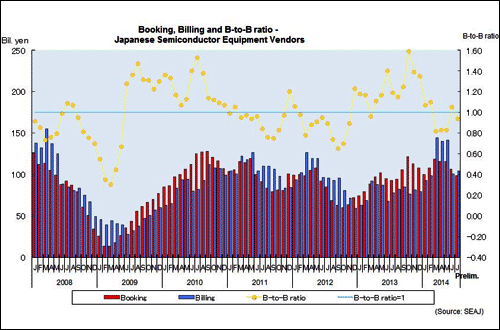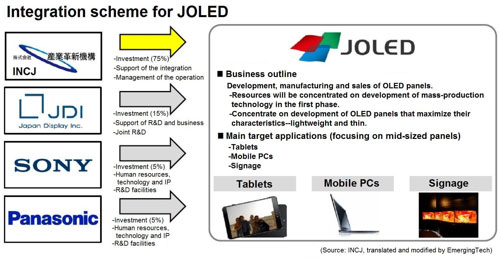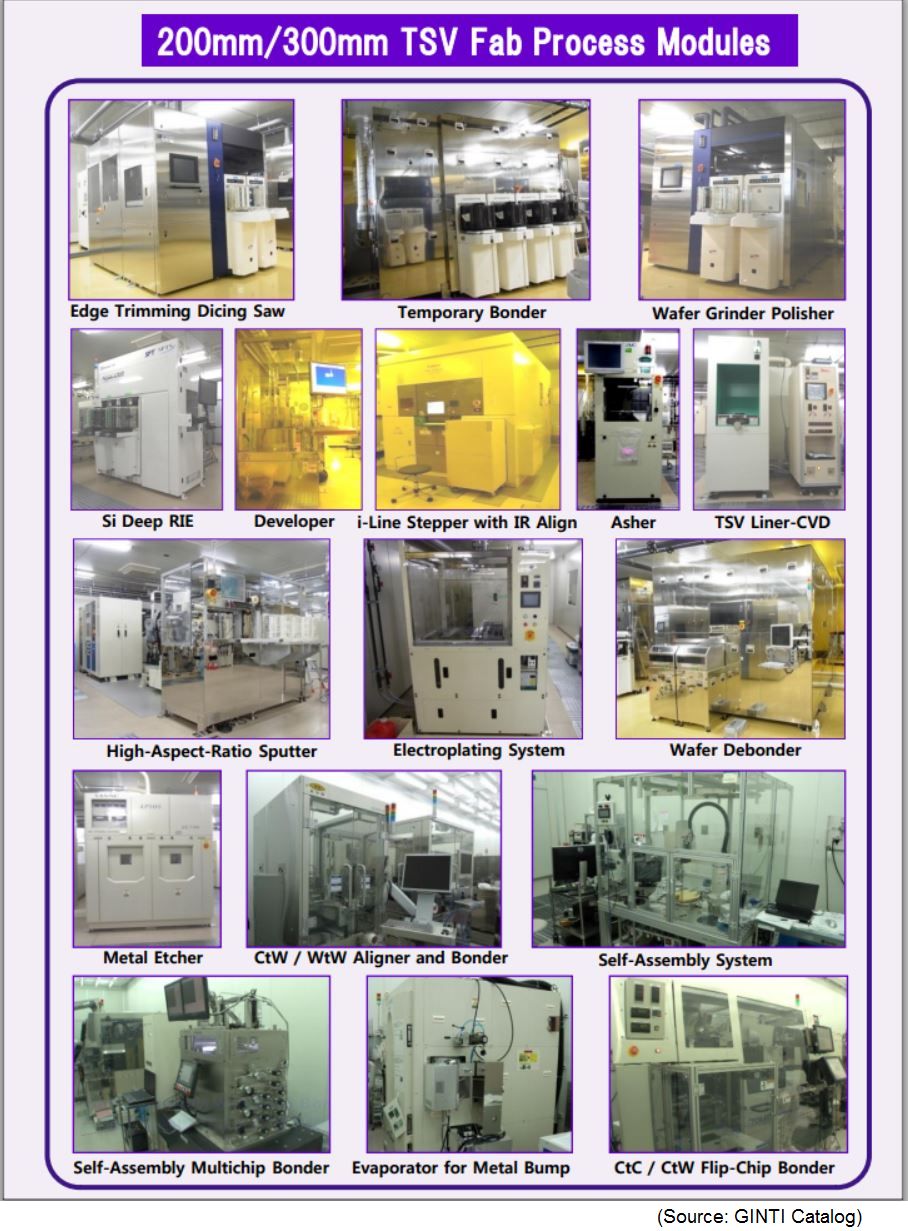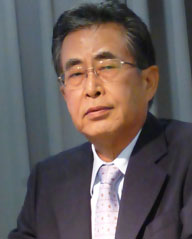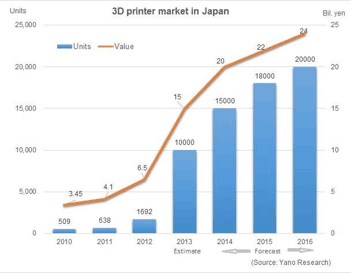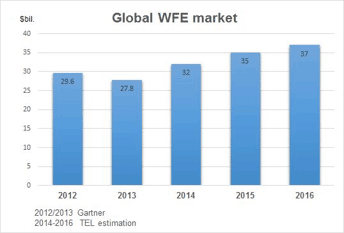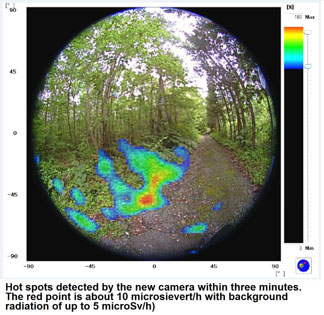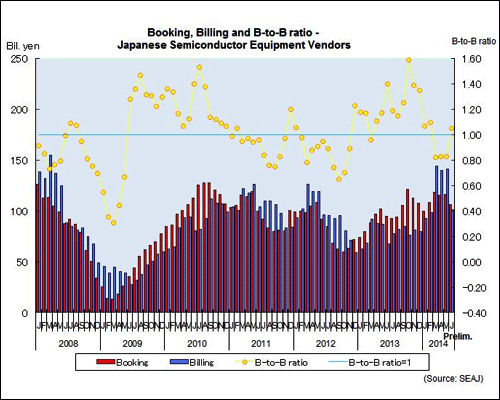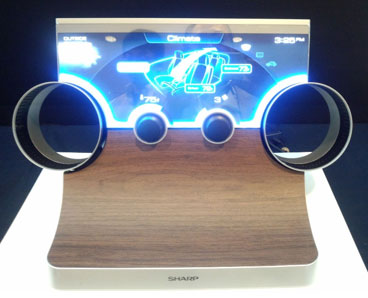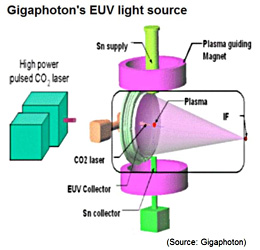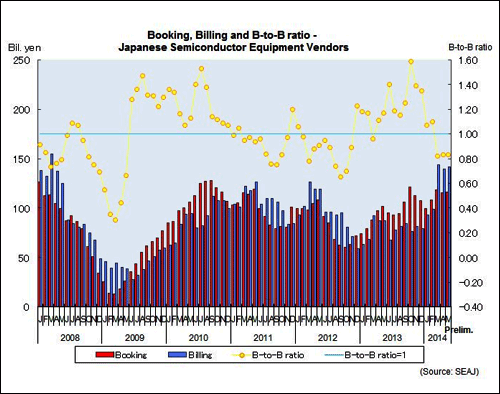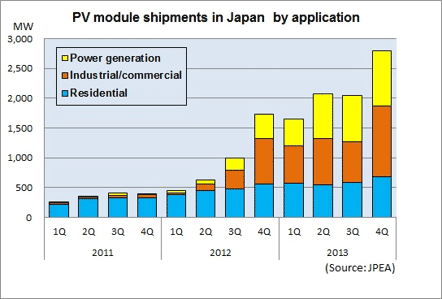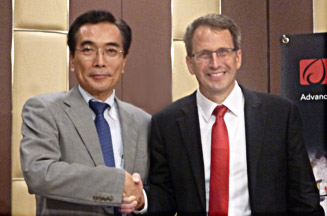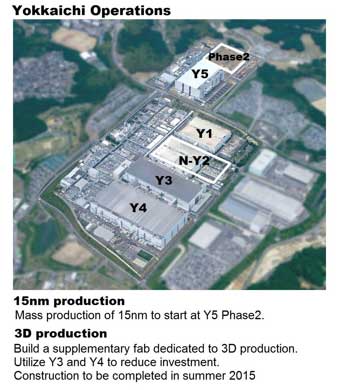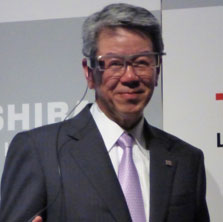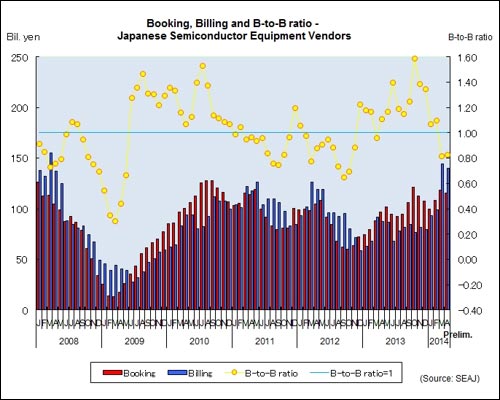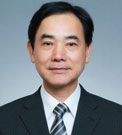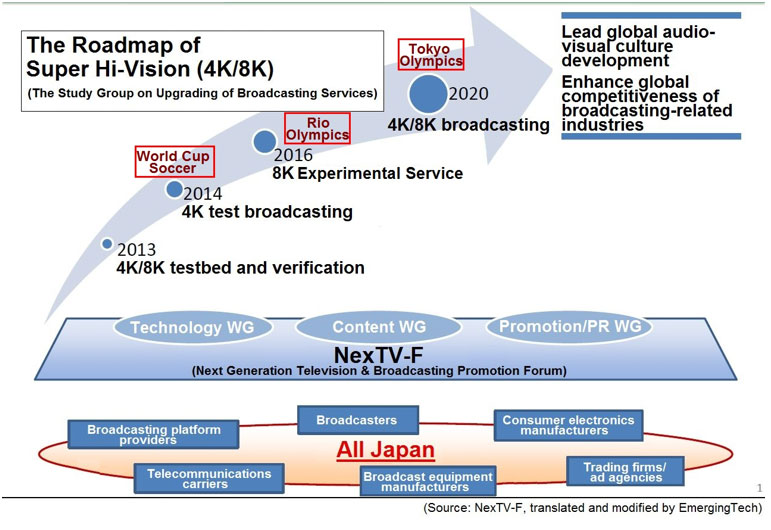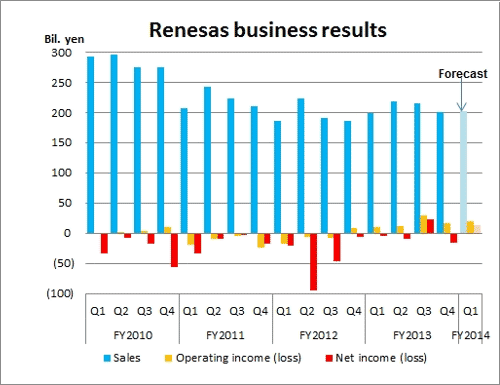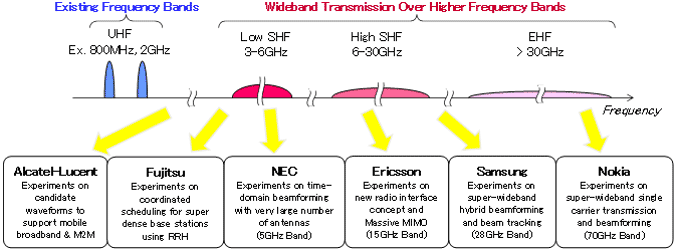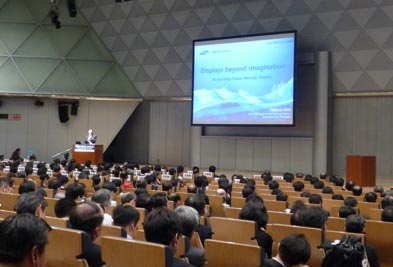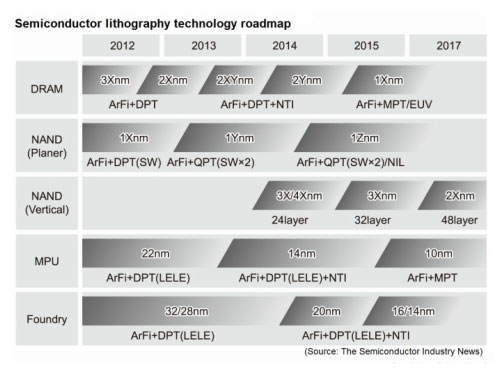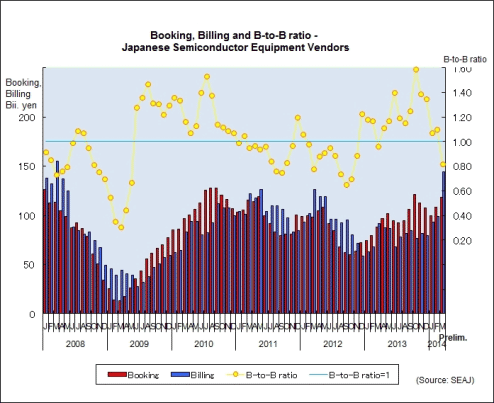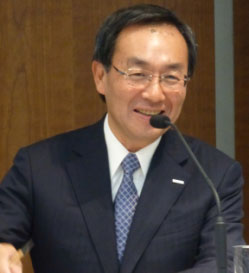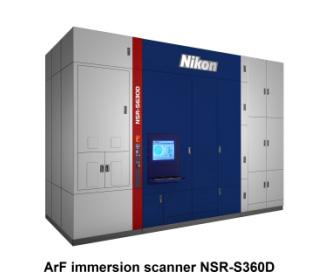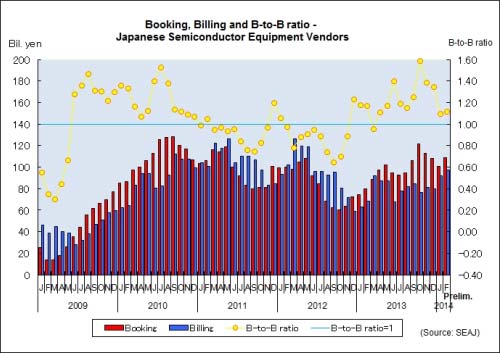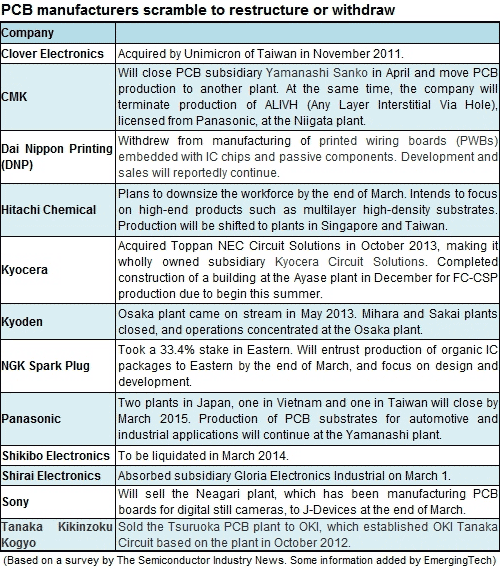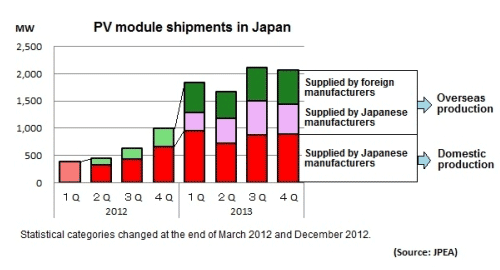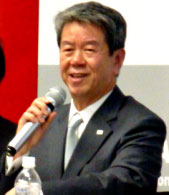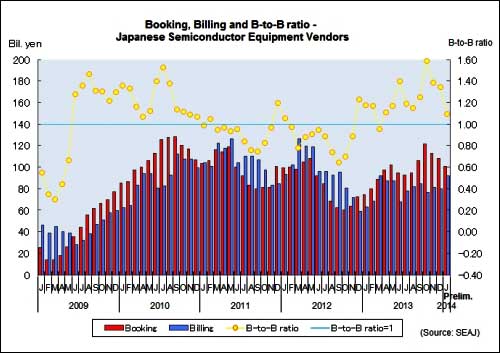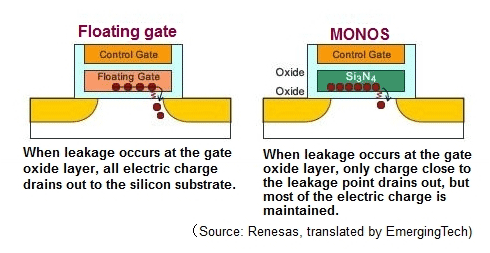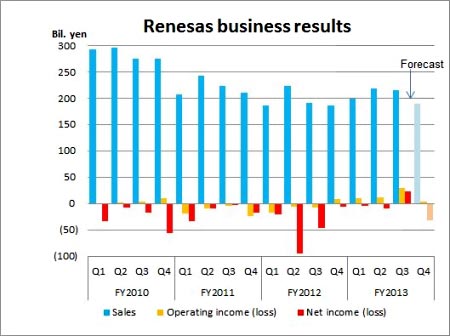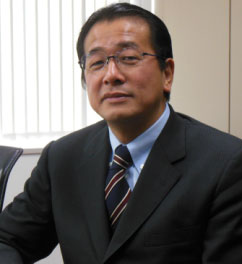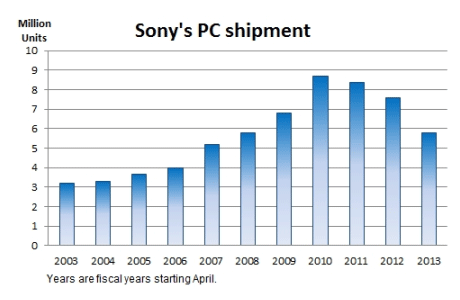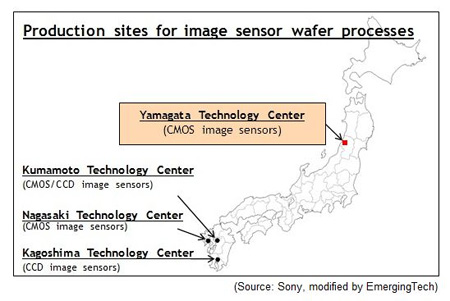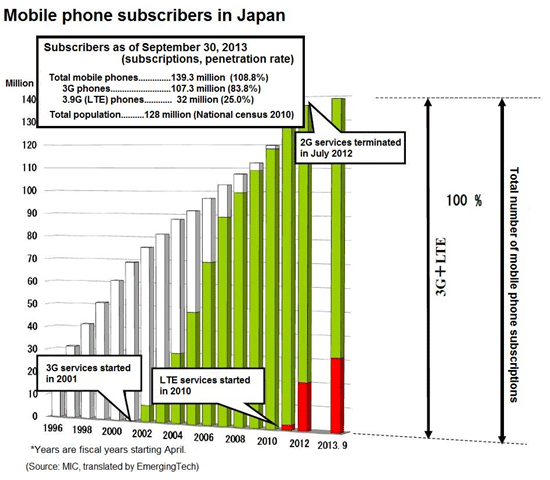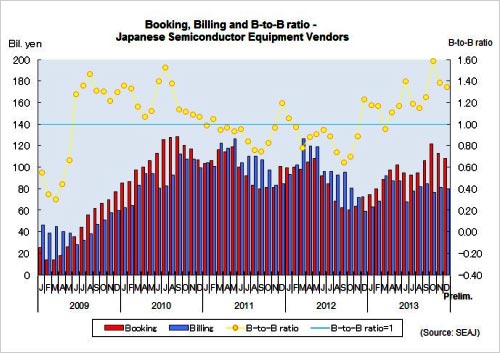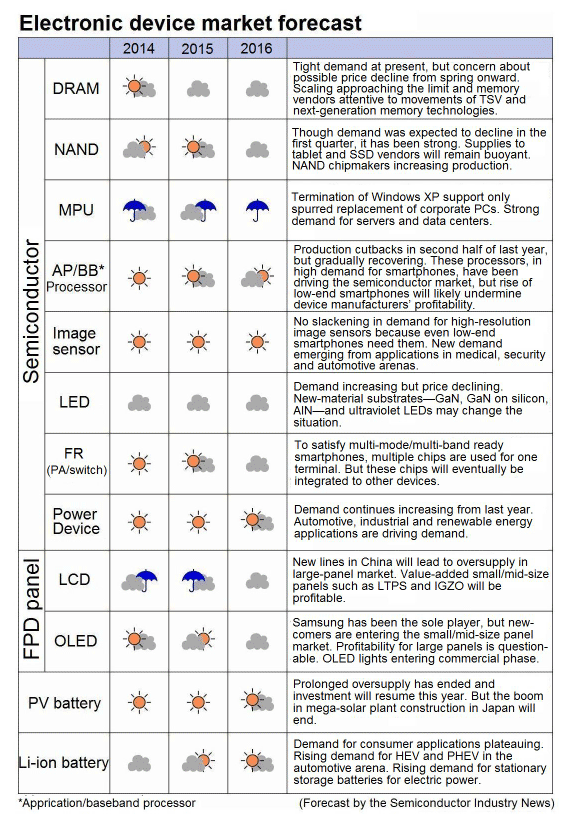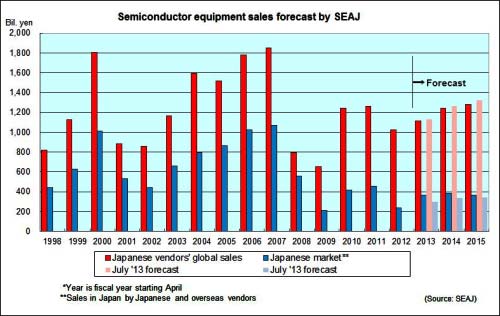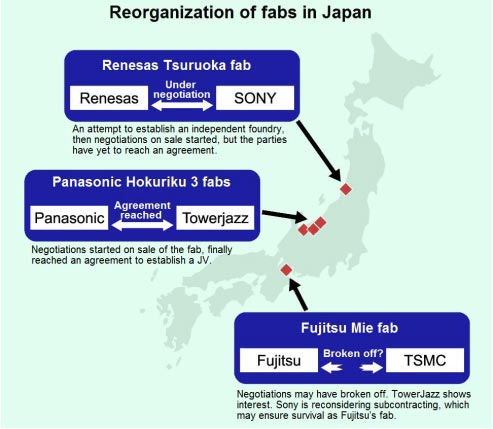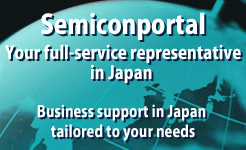News Center
"The IT industry is inexorably approaching maturity. Sure, the recent surge in orders for semiconductor production equipment may lead people to imagine that the go-go times are about to return. But unless the electronic device industry finds new growth vectors, the future won't be bright," said Akira Minamikawa, one of Japan's most respected semiconductor industry analysts.
[... more]
Murata Cheerleaders, a team of small robots created by Murata Manufacturing Co., Ltd. using sensing, communication and group control technologies, will debut at CEATEC next week in Makuhari on Tokyo Bay, performing synchronized dancing without colliding. Cute!
[... more]
Demand for smartphones and other mobile gizmos is booming and motor vehicles are packed with more and more electronic gear. With these two big applications to the fore, robust growth of the semiconductor and display markets is in prospect for 2014 and 2015.
[... more]
The book-to-bill ratio of Japan-based manufacturers of semiconductor equipment was 0.97 in August, staying below 1, according to the book-to-bill ratio report issued by the Semiconductor Equipment Association of Japan (SEAJ).
[... more]
Sharp Corp. has demonstrated a MEMS display jointly developed with Qualcomm subsidiary Pixtronix Inc. and announced it will be commercialized in 2017. The Japanese company will deploy this new display—dubbed the MEMS-IGZO display because it is a fusion of MEMS and IGZO technologies—in a bid to expand the use of displays to applications beyond the reach of LCDs.
[... more]
Rohm Co., Ltd. has started a foundry service for fabricating microelectromechanical systems (MEMS) integrating thin-film piezoelectric element technology, which the company claims is the first such foundry service in the world.
[... more]
NGK Insulator Ltd. has developed a solid-state ceramic lithium-ion battery whose density is roughly 10 times that of conventional solid-state batteries, and moreover, it is capable of working at high temperature of about 120 degrees centigrade, enabling it to be closely apposed with chips on a circuit board.
[... more]
Toshiba Corp. and partner SanDisk Corp. have opened the second phase of Fab 5, which began fabricating 15nm NAND memories this month, and started construction on schedule of the new Fab 2 at Yokkaichi Operations, Toshiba’s NAND Flash memory plant in Mie prefecture, Japan.
[... more]
United Microelectronics Corp. (UMC) and Fujitsu Semiconductor Ltd. announced at the end of last month an agreement whereby the Taiwanese foundry will become a minority shareholder in the Japanese firm, in what appears to be the last in a series of moves to reorganize the major fabs of Japanese chipmakers. Highlights of the recent round of restructuring have included Sony's acquisition of Renesas' 300mm fab, Panasonic's sale of its principal fabs to TowerJazz, and the establishment of an SoC design JV by Fujitsu and Panasonic.
[... more]
"The worldwide PV installation boom has subsided, with one big exception—Japan. More than 2,000 megasolar installations are planned in this country," the bullish editor-in-chief of an industry magazine said to me the other day. He contended, "Japan is at the epicenter of what promises be a new boom in PV installations."
[... more]
Renesas Electronics Corp. has announced the R-Car V2H system-on-chip LSI, its first product dedicated for advanced driver assistance system (ADAS) applications. Sampling begins this month.
[... more]
A team at the Institute for Chemical Research of Kyoto University has clarified the behavior of electrons and holes in organometal halide perovskite semiconductor (CH3NH3PbI3), which is a focus of growing interest as one of the most promising next-generation solar cells.
[... more]
On the eve of volume use of SiC power devices, there is an urgent need to lower the cost of SiC wafers, which is why the wafer production technology of Sicoxs Corp., a Tokyo-based venture company, is coming under the spotlight.
[... more]
The book-to-bill ratio of Japan-based manufacturers of semiconductor equipment was 0.94 in July, back below 1 again, according to the book-to-bill ratio report issued by the Semiconductor Equipment Association of Japan (SEAJ).
[... more]
Innovation Network Corporation of Japan (INCJ), a government-backed investment fund, together with Japan Display Inc., Sony Corp., and Panasonic Corp., will launch a new company, JOLED Inc., in January next year, integrating the R&D functions of Sony and Panasonic for organic light-emitting diode (OLED) display panels. Through this collaboration, the companies aim to accelerate development and expedite commercialization of OLED display panels.
[... more]
The Global Integration Initiative (GINTI), a center equipped with facilities and an environment for R&D, prototyping and pilot production of 3D stacked LSIs, started a full-service operation in Miyagi Prefecture in April.
[... more]
Renesas Electronics Corp., now in the midst of restructuring, has reported first-quarter business results superior to the forecast it announced in May. Renesas CEO Hisao Sakuta, who has been in charge since June 2013, talked frankly about the next steps in the restructuring. He observed that although it is clear what has to be done, restructuring has only reached the halfway point.
[... more]
The hydrogen energy era is on the way. Toyota has announced it may commercialize hydrogen-powered fuel cell vehicles (FCVs) next year and has set itself the target of cutting the cost per vehicle to 5 million yen (US$50,000*)—one-twentieth of the current cost. Likewise, Honda plans to introduce FCVs next year. Nissan is targeting introduction in 2017, slightly behind its competitors.
[... more]
The Ministry of Economy, Trade and Industry (METI) predicted last February that the global market for 3D printers and materials will reach 1 trillion yen (US$10 billion*) in 2020, roughly quadrupling from 230 billion yen in 2012.
[... more]
Tokyo Electron Ltd., having reported 46% year-on-year sales growth for the first quarter and a more than sixfold increase in operating profit, has revised its forecast for the first half of this fiscal year, raising the figure for sales 12 billion yen (US$120 million*) to 290 billion yen and that for operating profit 6.5 billion yen to 24.5 billion yen.
[... more]
Japanese chipmakers have been manufacturing some products for more than two decades. This prompted an executive of Massachusetts-based aftermarket manufacturer Rochester Electronics to comment that the Japanese semiconductor industry seems to have no policies on discontinuing production of obsolete devices. Though his comment contains more than a grain of truth, Japan's chipmakers are reviewing their business practices and have started winnowing their product portfolios.
[... more]
Waseda University and Hamamatsu Photonics K.K. have developed a handy Compton camera whose high sensitivity enables it to locate gamma radiation within a few seconds.
[... more]
Applied Materials, Inc. and Tokyo Electron Ltd., now carrying out the procedures to complete their merger, have announced the name and logo of the holding company that is to be based in the Netherlands following the merger. It will be called Eteris, which is derived from "eternal innovation for society," a concept that is said to express the new company's spirit.
[... more]
Fujitsu Ltd. is negotiating with United Microelectronics Corp. with a view to selling its 300mm wafer fab in Mie Prefecture to the Taiwanese company, and with Phoenix, Arizona-based, On Semiconductor on the proposed sale of its Aizu fab in Fukushima Prefecture, media reported. The contemplated disposals would signal virtually a complete withdrawal by Fujitsu from semiconductor fabrication.
[... more]
Displays have always been squeezed into a rectangular straitjacket. Even if a display has rounded corners or is curved, the basic form is rectangular. Now, here comes Sharp Corp. with its revolutionary Free-Form Display to set displays free. The FFD allows great freedom in the design of display shape. Sharp developed the panel by implementing gate drivers within pixel areas, not at the edges as in conventional panels. Sharp calls it in-pixel gate driver monolithic (IPGDM) technology.
[... more]
Applied Materials, Inc. and Tokyo Electron Ltd., now carrying out the procedures to complete their merger, have announced the name and logo of the holding company that is to be based in the Netherlands following the merger. It will be called Eteris, which is derived from "eternal innovation for society," a concept that is said to express the new company's spirit.
[... more]
Gigaphoton Inc., a wholly owned subsidiary of Komatsu Ltd., has developed a prototype laser-produced plasma (LPP) light source unit that achieved 92W extreme ultraviolet (EUV) light source output at 4.2% conversion efficiency—more than doubling the company's previous result of 43W.
[... more]
"What happened? I've never seen such a rush of orders. As semiconductor investment has been in low gear, we can't replenish production facilities and manpower immediately. We are naturally delighted about the tremendous amount of orders, but the deadlines keep us awake at night," said a gleeful executive of a Japanese manufacturer of wafer fab equipment.
[... more]
Electronic components have grown in importance to the point that they are the face of Japan's electronics industry. With input from Yuzuru Sato, an analyst with Tokyo-based DG Research, who tracks the industry, we identify what is hot and how this fiscal year is shaping up.
[... more]
Toyota Motor Corp. has made clear it intends to use SiC power devices, currently under development in house, in mass-produced cars by around 2020. The company plans to begin test runs of cars equipped with the devices on public roads within a year.
[... more]
The book-to-bill ratio of Japan-based manufacturers of semiconductor equipment was 0.82 in May, staying below 1 for the third successive month, according to the book-to-bill ratio report issued by the Semiconductor Equipment Association of Japan (SEAJ).
[... more]
Nikon Corp. announced a three-year business plan calling for sales to increase 22% to 1,200 billion yen (US$12 billion*) and operating profit 75% to 110 billion yen within the term of the plan. For a new medical business unit, the sales target is 130 billion yen in fiscal 2016, starting from zero, with M&A set to play a major role.
[... more]
In contrast to the slowing pace of PV system installation in Europe, PV module shipments in the Japanese market doubled last year to 8.6GW, giving Japan a growth rate second only to China's. In this expanding market, overseas suppliers' raised their share to almost 30%, according to the Japan Photovoltaic Energy Association (JPEA).
[... more]
Renesas Electronics Corp. has agreed to sell subsidiary Renesas SP Drivers Inc. to Santa Clara, California-based, Synaptics Inc., an interface solutions vendor. Synaptics expects the acquisition of the LCD driver company, whose annual sales figure is equivalent to more than 75% of its own, will enable it to address a market worth 50% more than the one it currently serves.
[... more]
Toyota Motor Corp. and Panasonic Corp. have been working together since last June to connect home appliance control with Toyota's telematics service. This collaboration is about to bear fruit as a new service that is scheduled to be launched in the second half of this year.
[... more]
I relished a recent opportunity to listen to G. Dan Hutcheson, CEO and chairman of VLSI Research Inc., share his insights, especially as I hadn't heard his take on the semiconductor industry for quite a while. Not only is Dan Hutcheson an acknowledged authority on the industry, he is also one of its most distinctive voices. In particular, his analyses of production equipment and process technologies tend to outshine the observations of other commentators.
[... more]
Panasonic Corp. and Sony Corp. are in negotiations to sell their OLED businesses to Japan Display Inc., which will establish a company specializing in OLED, with government-backed Innovation Network Corp. of Japan (INCJ) taking a majority stake in the venture, media reported. The parties reportedly intend to conclude the negotiations within this month.
[... more]
Toshiba Corp., with partner SanDisk, will build a fab dedicated to 3D NAND process at its Yokkaichi Operations in Japan. The fab is slated for completion in summer 2015 and production is scheduled to begin in the second half of fiscal 2015. Investment in the project is expected to reach 500 billion yen (US$5 billion*).
[... more]
Toshiba Corp. announced a 3-year business plan for fiscal 2014 to fiscal 2016 calling for growth of 1 trillion yen or 15% in sales in fiscal 2016 compared with fiscal 2013, and which targets sales of 7.5 trillion yen (US$75 billion*) in the plan's final year, ending March 2017, with operating profit of 450 billion yen and net profit of 200 billion yen.
[... more]
The book-to-bill ratio of Japan-based manufacturers of semiconductor equipment was 0.83 in April, according to the book-to-bill ratio report issued by the Semiconductor Equipment Association of Japan (SEAJ). The fact that the ratio has been below 1 for two consecutive months is considered largely attributable to a seasonal factor.
[... more]
On April 8, Sony Corp. opened Yamagata Technology Center, formerly Renesas' 300mm Tsuruoka fab, and disclosed a plan to establish monthly production capacity of 20,000 300mm wafers for CMOS sensors by March 2016. The project will involve investing about 28 billion yen (US$280 million*) to refurbish existing equipment and install new equipment.
[... more]
Kazuo Ushida, senior executive vice president and president of Nikon Precision Equipment Company, will take office as president of Nikon Corp. following approval at a general meeting of shareholders on June 27.
[... more]
"As a national strategy, Japan will begin 4K TV broadcasting in 2014 and lead the world by introducing 8K TV broadcasting in 2016," said Toshiyuki Minami, deputy director-general of the Information and Communications Bureau at the Ministry of Internal Affairs and Communications (MIC), in a keynote speech at FineTech Japan 2014 last month in Tokyo.
[... more]
Just a week or so after Samsung's announcement about its 3D NAND fab in Xian, China, Toshiba Corp. and SanDisk have announced that they will build a new fab for 3D NAND flash memories at Yokkaichi Operations in Mie Prefecture, replacing the idle Fab 2.
[... more]
Renesas Electronics Corp., currently in the midst of restructuring underpinned by a 150 billion yen (US$1.5 billion*) capital injection from the Innovation Network Corporation of Japan (INCJ), has reported its business results for fiscal 2013 ended in March—the eye-catcher is the first full-year operating profit since fiscal 2010, the year it was established, and reported marginal operating profit.
[... more]
Targeting next-generation 5G mobile communications services whose launch is slated for around 2020, NTT Docomo Inc. has agreed with six companies—Alcatel-Lucent, Ericsson, Fujitsu, NEC, Nokia and Samsung Electronics—to jointly develop related technologies and conduct trials with each of them.
[... more]
Panasonic Corp. will sell a majority interest in its surface acoustic wave (SAW) filter business for 148.5 million dollars to Woburn, Massachusetts-based, Skyworks Solutions Inc., which will establish a JV on August 1 in which Panasonic will have a 34% equity stake.
[... more]
The worldwide flat display market is forecast to be worth 162 billion dollars in 2014, about half the value of the semiconductor market. But average annual growth in the decade from 2010 to 2020 is expected to be 7.4%, leisurely compared with the explosive growth in the past, and slowing with every passing year.
[... more]
The outlook for next-generation lithography, the key technology in the semiconductor industry, is in flux. The latest snapshot reveals that EUV lithography is no longer necessarily in pole position, while ArF immersion technology with multi-patterning has emerged as the most practical solution for 10nm and maybe even 7nm.
[... more]
As already reported in outline by the media, Fujitsu Ltd., Panasonic Corp. and the state-owned Development Bank of Japan, Inc. (DBJ) have agreed to form a yet-to-be-named JV fabless company by the end of the year—once antitrust authorities in various jurisdictions are staisfied—specializing in system LSI design and development.
[... more]
Toshiba Corp. announced it has taken the lead in advancing process technology to 15nm, which it calls the 1Znm process, and will begin producing NAND flash memory using the process at the end of this month at Fab 5 of its Yokkaichi Operations.
[... more]
Thanks to adoption by Tokyo Electric Power Company (TEPCO) for its smart meter system, Wi-SUN is gaining momentum and seems destined to be the major communications format in Japan for M2M communications.
[... more]
The book-to-bill ratio of Japan-based manufacturers of semiconductor equipment was 0.87 in March, according to the book-to-bill ratio report issued by the Semiconductor Equipment Association of Japan (SEAJ). The ratio dropped below 1 after 11 consecutive months above 1, as billing, surged to the highest level in six years.
[... more]
Fujitsu Ltd. and Panasonic Corp. have agreed to establish a fabless JV this autumn by integrating their system-on-chip LSI design businesses, using investment by the Development Bank of Japan for that purpose, media reported.
[... more]
I was born and bred in Yokohama, where my family has been running a busy restaurant specializing in delicious soba noodles, a Japanese favorite, for more than 130 years. Looking back to my childhood, I have vivid memories of workers from factories across the Keihin Industrial Zone* dropping into our shop to eat, drink, talk about everything under the sun and generally have a good time.
[... more]
April 1 looms large in the Japanese calendar. For government and most companies it signaled the start of fiscal 2014. This year the date had added significance because consumption tax jumped from 5% to 8% on that day. There are fears that the tax hike will be like a bucket of cold water chucked over the Japanese economy, which after marking time for more than 20 years, is at last showing signs of renewed vitality.
[... more]
Semiconductor production equipment manufacturers' expectations of the post-sales business, including refurbishing used equipment and after-sales services, are on the rise as they endeavor to turn it into a major revenue stream. This is certainly true of Canon, whose imminent acquisition of Austin, Texas-based Molecular Imprints Inc., a nanoimprint system manufacturer, indicates its aggressive plans concerning leading-edge lithography systems.
[... more]
Apple Inc. is negotiating with Renesas with a view to acquiring the Japanese company's subsidiary Renesas SP Drivers Inc., attracted by its technology, Nikkei reported from Silicon Valley.
[... more]
Panasonic Corp. announced a new sales target of 10 trillion yen (US$100 million*) for fiscal 2019**, its centennial year, and what's more, aims to hit that number mainly on the strength of businesses other than consumer electronics, signaling dramatic change for an enterprise that has traditionally been synonymous with consumer electronics.
[... more]
Nikon Corp., which has promised to ship a 450mm tool in 2015, intends to boost ArF immersion lithography technology with its newly announced NSR-S630D for 300mm lines and is positioning the upcoming 450mm tool as an extension of ArF technology.
[... more]
Mitsubishi Electric Corp. launched its new Power Device Innovation Center earlier this month to concentrate development, design and sales of power devices at its Power Device Works in Kitakyushu, Fukuoka prefecture. Thus, sales, design and development operations for power devices are now integrated under one roof alongside the company's manufacturing plant for these products. The center represents investment totaling 2.5 billion yen (US$25 million).
[... more]
The book-to-bill ratio of Japan-based manufacturers of semiconductor equipment was 1.12 in February, according to the book-to-bill ratio report issued by the Semiconductor Equipment Association of Japan (SEAJ).
[... more]
Following the arrest of a former SanDisk engineer who is alleged to have stolen technical data from Toshiba's Yokkaichi NAND operations and provided it to SK Hynix Inc. when he took up a job with the Korean company, Toshiba Corp. and SanDisk Corp. respectively filed lawsuits against Hynix seeking redress.
[... more]
The restructuring of Japan's PCB sector has accelerated, reflecting the rapid contraction of domestic business as customers shift operations overseas and adopt new manufacturing processes.
[... more]
"I hear that Mitsubishi Heavy Industries is building a national regional jet and Honda* is building a small business jet with their own technologies. But I am wondering why Japanese manufacturers can't make top-of-the-line fighters and big airliners, which will bring bigger business."
[... more]
Japan's PV market has been transformed in composition and scale since the feed-in tariff scheme was introduced in July 2012. No longer a market dominated by Japanese manufacturers and skewed toward residential installations, overseas suppliers account for an increasing share of a growing market in which non-residential PV installations are the fastest-growing segment.
[... more]
Thine Electronics, Inc. announced that it has licensed its V-by-One HS display interface technology to Qualcomm Technologies, Inc., a subsidiary of Qualcomm Inc. Buoyed by the announcement on Monday, the share price of Thine Electronics, Japan's leading fabless company, has soared more than 15% since last week on the JASDAQ stock market.
[... more]
Semiconductor production equipment manufacturers' expectations of the post-sales business, including refurbishing used equipment and after-services, are on the rise as they endeavor to develop it into a major revenue stream. This is certainly true of Tokyo Electron, which is setting up a dedicated organization to aggressively promote its post-sales business.
[... more]
To promote commercialization and take-up of solid hydrogen-source fuel cells, the Kyoto Fuel Cell Alliance* was launched by Rohm, Kyoto University, Aquafairy and others in January. The alliance's mission is to promote commercialization of the fuel cell system, develop applications, establish an international standard for the system, and secure intellectual property. The alliance includes organizations from industry, academia and government. The kickoff meeting was held on January 9 in Kyoto.
[... more]
Positioning healthcare as its third mainstay business alongside Storage and Energy, Toshiba Corp. set an ambitious target in its 3-year business plan announced last August: drive growth of the healthcare business to 600 billion yen (US$6 billion*) in sales in fiscal 2015, a roughly 50% increase from fiscal 2013, and then keep on climbing to 1 trillion yen (US$10 billion*) in fiscal 2017. Toshiba went public on Thursday with its strategy for hitting these big numbers, showcased the technologies it hopes will underpin expansion, and made it clear that, in addition to organic growth, it will pursue growth through aggressive M&A.
[... more]
The book-to-bill ratio of Japan-based manufacturers of semiconductor equipment was 1.10 in January according to the book-to-bill ratio report issued by the Semiconductor Equipment Association of Japan (SEAJ), the third consecutive month-on-month decline.
[... more]
Renesas Electronics Corp. announced it has developed a 28nm embedded flash memory intellectual property based on its proprietary MONOS flash structure and that the IP satisfies requirements such as data retention time, cycle time and speed for embedded flash memory of microcontrollers for automotive applications.
[... more]
Capital investment by the global semiconductor industry is estimated at 5 trillion yen (US$50 billion*) for 2013, roughly the same as for the previous year. As you may know, the value of the global semiconductor market edged up to 30 trillion yen from the previous year, as if to rub in the fact that the days when the market grew by leaps and bounds are long gone.
[... more]
Canon Inc. has announced that it agreed with Austin, Texas-based Molecular Imprints, Inc., on February 5 to acquire the American company and will make it a wholly owned subsidiary, which means Canon has selected nanoimprint as its next-generation lithography technology.
[... more]
Toshiba will invest about 40 billion yen (US$400 million*) in its Yokkaichi NAND fab, NHK, Japan's sole public broadcasting station, reported today.
[... more]
Renesas Electronics Corp. announced its business results for the third quarter of fiscal 2013 together with the forecast for the full year ending March 2014. The company not only recorded an operating profit of 30 billion yen (US$300 million*) for the quarter—making it the fourth consecutive quarter in the black—but forecast an operating profit of 54.7 billion yen for the full year, which would be Renesas' first fiscal year in the black since its foundation in 2010.
[... more]
Electronic design automation (EDA) is indispensable for developing, designing, and manufacturing electronic products. In the CAD/CAM system arena, when it comes to EDA for PCB design, Zuken Corp. retains its lead in Japan and the second position in the global market.
[... more]
Sony Corp. is negotiating the sale of its PC business, featuring the Vaio brand, to Japan Industrial Partners, Inc., a Tokyo-based investment fund, media reported.
[... more]
Sony Corp. has agreed to acquire Renesas Electronics Corp.'s Tsuruoka fab, a 300mm facility, for 7.5 billion yen (US$75 million*) and will reposition it as Yamagata Technology Center (Yamagata TEC), a unit of its wholly owned subsidiary Sony Semiconductor Corp. (SCK), for fabrication of back-side illuminated (BSI) CMOS sensors. The transaction is to be completed on March 31.
[... more]
The skyrocketing amounts of data involved in semiconductor manufacturing processes make analysis methodologies similar to those required for big data analysis essential. This was the context for discussion at AEC/APC Symposium Asia 2013, held in Tokyo last November, on measures to cope with the rising tide of data associated with semiconductor manufacturing processes.
[... more]
The Ministry of Internal Affairs and Communications (MIC) held a public hearing last Thursday to allocate bandwidth for the coming LTE-Advanced services. Invited to the hearing were Docomo, KDDI, Softbank and eAccess-the four mobile carriers that had applied for bandwidth for 4G mobile services. These companies intend to begin 4G services in 2015 or 2016.
[... more]
The book-to-bill ratio of Japan-based manufacturers of semiconductor equipment was 1.35 in December according to the book-to-bill ratio report issued by the Semiconductor Equipment Association of Japan (SEAJ), the second consecutive month-on-month decline, but still at a high level.
[... more]
Renesas Electronics Corp. has launched a product longevity program that clearly indicates the period during which Renesas assures supply for each product. The program targets coverage of over 5,000 current and yet-to-be-released products comprising MCUs and analog and power devices, and eventually system-on-chip LSIs will be included too.
[... more]
Renesas Electronics Corp., which is restructuring under a new management team appointed last June by the Innovative Network Corp. of Japan (INCJ), is reportedly preparing to eliminate 5,400 jobs in Japan by the end of fiscal 2015 (March 2016).
[... more]
Sluggish demand for the general run of electronic devices—including semiconductors, displays, and so forth, as well as for batteries, is in prospect as leading smartphone vendors curb first-quarter production. In presenting its market forecast, The Semiconductor Industry News cautions that spring may be cancelled or at least be disappointing this year. The climate remains good but bad weather is likely, so hang on to your umbrella.
[... more]
Global sales by Japanese semiconductor equipment manufacturers for fiscal 2014 starting April will increase 11.6%, following modest growth of 8.5% for this fiscal year ending March, according to the latest forecast announced on Wednesday by the Semiconductor Equipment Association of Japan (SEAJ).
[... more]
Of three major negotiations on the change of ownership of wafer fabs in Japan, one, between Panasonic and TowerJazz, recently resulted in a deal. But as for the other two, the parties have yet to reach agreement and the final outcomes remain difficult to predict.
[... more]
2014 is shaping up to be a good year for Japan's electronics industry. On the plus side, the industry should benefit from an economic recovery engineered by the Abe administration as well as a weaker yen, many companies should be in better shape having restructured their operations, and Tokyo's selection as host for the 2020 Olympics is an additional tonic. On the other hand, naysayers worry about the impact of the consumption-tax hike due in April.
[... more]
Warning: Invalid argument supplied for foreach() in /home2/semicon/hosting/spiwww/include/Banner.php on line 78
Warning: array_multisort(): Argument #1 is expected to be an array or a sort flag in /home2/semicon/hosting/spiwww/include/Banner.php on line 81
Warning: Invalid argument supplied for foreach() in /home2/semicon/hosting/spiwww/include/Banner.php on line 85


